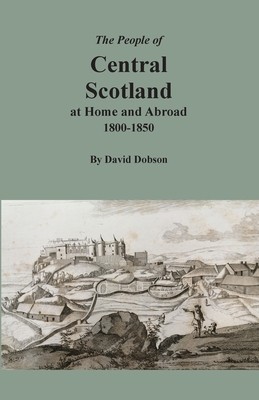
- We will send in 10–14 business days.
- Author: David Dobson
- Publisher: Clearfield
- ISBN-10: 0806359528
- ISBN-13: 9780806359526
- Format: 14 x 21.6 x 0.8 cm, softcover
- Language: English
- SAVE -10% with code: EXTRA
The People of Central Scotland at Home and Abroad, 1800-1850 (e-book) (used book) | bookbook.eu
Reviews
Description
Central Scotland includes the counties of Stirlingshire and neighboring Clackmannanshire, which stretch from Loch Lomond and the Trossachs to the upper reaches of the River Forth. The region is partly in the Highlands and partly in the Lowlands. Most of the early emigration from Central Scotland was by individuals or family groups, but in 1773 the Arnprior Emigration Society formed by farmers in west Stirlingshire organized an emigration to Vermont. In the early 19th century three other emigration societies in Stirlingshire"""Alloa in 1817, Balfron in 1821, and Deanston in 1821"""organized groups of emigrants bound to Upper Canada. The entries in this work, to some extent, enable family historians in the Americas, Australasia, and other locations to link with their kin who remained in Scotland. The Statistical Account of Scotland (OSA), compiled between 1791 and 1799, and the New Statistical Account of Scotland (NSA), compiled between 1832 and 1845, are especially helpful for understanding Scottish society of the period. These can be consulted in major libraries, such as the National Library of Scotland, or online. In the late 18th century, the regional economy was based on farming, textiles, and mining. The existence of iron and coal enabled industrialization to occur relatively early. Coalmining rapidly expanded due to domestic demand and industrial expansion, especially the adoption of the Bolton and Watt steam engines in Scottish textile mills. Supplies of flax were imported from the Baltic, and the linen manufactured became an important export for Central Scotland. The nearly simultaneous Agricultural Revolution caused the merging of small farms, creating a rural labor surplus that either moved to the burgeoning factory towns in the Lowlands or emigrated.
EXTRA 10 % discount with code: EXTRA
The promotion ends in 20d.17:27:31
The discount code is valid when purchasing from 10 €. Discounts do not stack.
- Author: David Dobson
- Publisher: Clearfield
- ISBN-10: 0806359528
- ISBN-13: 9780806359526
- Format: 14 x 21.6 x 0.8 cm, softcover
- Language: English English
Central Scotland includes the counties of Stirlingshire and neighboring Clackmannanshire, which stretch from Loch Lomond and the Trossachs to the upper reaches of the River Forth. The region is partly in the Highlands and partly in the Lowlands. Most of the early emigration from Central Scotland was by individuals or family groups, but in 1773 the Arnprior Emigration Society formed by farmers in west Stirlingshire organized an emigration to Vermont. In the early 19th century three other emigration societies in Stirlingshire"""Alloa in 1817, Balfron in 1821, and Deanston in 1821"""organized groups of emigrants bound to Upper Canada. The entries in this work, to some extent, enable family historians in the Americas, Australasia, and other locations to link with their kin who remained in Scotland. The Statistical Account of Scotland (OSA), compiled between 1791 and 1799, and the New Statistical Account of Scotland (NSA), compiled between 1832 and 1845, are especially helpful for understanding Scottish society of the period. These can be consulted in major libraries, such as the National Library of Scotland, or online. In the late 18th century, the regional economy was based on farming, textiles, and mining. The existence of iron and coal enabled industrialization to occur relatively early. Coalmining rapidly expanded due to domestic demand and industrial expansion, especially the adoption of the Bolton and Watt steam engines in Scottish textile mills. Supplies of flax were imported from the Baltic, and the linen manufactured became an important export for Central Scotland. The nearly simultaneous Agricultural Revolution caused the merging of small farms, creating a rural labor surplus that either moved to the burgeoning factory towns in the Lowlands or emigrated.


Reviews